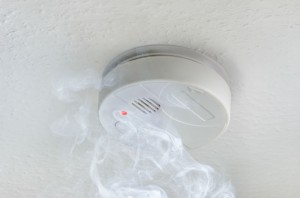In honor of October being Fire Prevention Month, we at Unlimited Security would like to talk about ways you as a homeowner can prevent a devastating house fire. In our first part of this series, we will focus on smoke alarms. Do you know where your smoke alarms are or where they should be placed? Do you know about the different types of smoke alarms? Do you know smoke alarm maintenance? Do you know carbon monoxide detector alarms are just as important as smoke alarms? We will answer all of these questions and provide you with some smoke alarm safety tips from the National Fire Prevention Association (NFPA).

A key part of an escape plan during a home fire, smoke alarms give you an early warning to get outside quickly as fire can spread in seconds. According to a 2010 telephone survey by the NFPA, 96% of all homes in the United States have at least one smoke alarm installed. However, this means approximately five million homes have no smoke alarm. This is alarming when you look at the statistics on home fires. Three out of every five deaths from a house fire were in homes with no smoke alarms or no working smoke alarms. For this reason, installing smoke alarms in your home is essential to your safety. All of the questions asked above are answered in the following smoke alarm safety tips from the NFPA:
- Smoke alarms should be installed both inside and outside every bedroom in your home. Install smoke alarms on every level of your home, including your basement.
- If you have a large home, you will most likely need extra smoke alarms.
- For your best protection, you should use an interconnected smoke alarm system. When one alarm sounds, every other alarm in your house will sound as well.
- At least once a month, you should test all of your smoke alarms. All you have to do is press the test button to be sure the alarm is working. Always have the batteries needed for your smoke alarms on hand.
- Smoke alarms come in two different kinds: ionization and photoelectric. To be extra safe, you should install both types of alarms in your home because they work together. Ionization smoke alarms alert you more quickly about flaming fires, and photoelectric smoke alarms are quicker to warn you about smoldering fires.
- You should install your smoke alarms on the ceiling or high up on your wall. To reduce false alarms, you should keep smoke alarms away from the kitchen. Smoke alarms should be placed at least 10 feet away from the stove.
- Deaf and hard of hearing people can use special smoke alarms, which shake the bed and flash strobe lights to alert those who cannot hear the alarm sound.
- When they reach the age of 10 years, smoke alarms should be replaced.
- Carbon monoxide alarms should be installed by the smoke alarms. Another safety necessity, carbon monoxide alarms can save your life.
Have more questions about smoke alarms? Contact Unlimited Security to ask our expert staff anything you would like to know.
